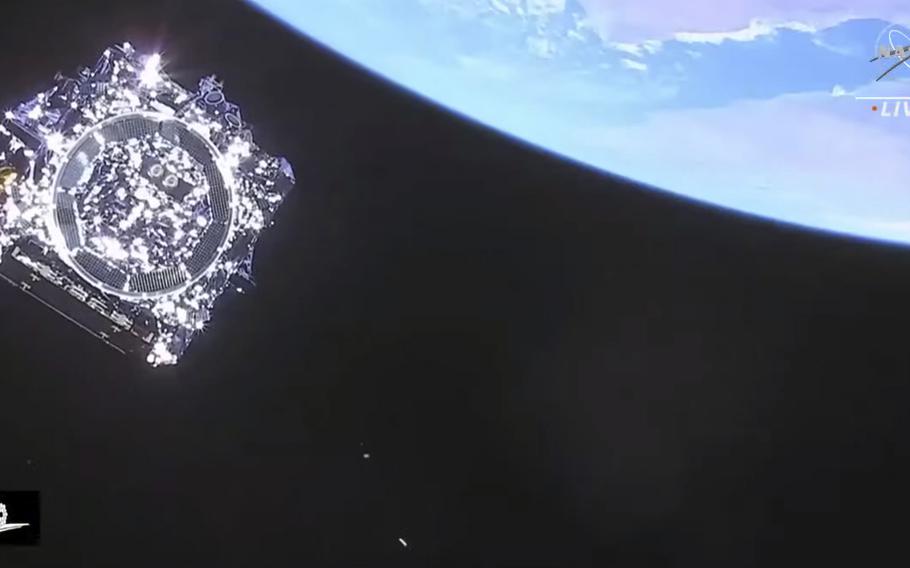
This photo provided by NASA, the James Webb Space Telescope is separated in space on Saturday, Dec. 25, 2021. NASA’s James Webb Space Telescope soared from French Guiana on South America’s northeastern coast, riding a European Ariane rocket into the Christmas morning sky. The $10 billion infrared observatory is intended as the successor to the aging Hubble Space Telescope. (NASA via AP)
NASA's revolutionary James Webb Space Telescope has transformed itself into what looks like a giant kite, successfully deploying a tennis-court-size sun shield designed to keep it operating at extremely cold temperatures. This was the most nerve-racking phase of the $10 billion mission so far, one flagged repeatedly by officials who had reviewed plans for the telescope and wondered if such a novel design could reliably work.
The telescope launched Christmas morning from French Guiana atop an Ariane 5 rocket. The telescope, including the sun shield and all other hardware, was folded up inside the cone of the rocket. It has since had to unfurl itself while hurtling through space. Engineers tested the sun shield on the ground but could not duplicate the conditions of space.
The effort to unfurl and then tighten the five-layer, 70-foot-wide sun shield — which NASA describes as providing protection against solar radiation equal to SPF 1 million — took several days, with commands sent from the Operations Center at the Space Telescope Science Institute in Baltimore.
The deployment concluded midday Tuesday with the "tensioning" of the fifth and final layer, a process involving mechanical release devices that account for more than half of the 344 potential single-point failures on this complex mission.
"It's a unique design, never been tried before, never been built before, never been successfully deployed in orbit," John Durning, the deputy project manager for the Webb mission, told The Washington Post early Tuesday.
The mission has had a couple of hiccups.
At one point, NASA project managers put deployments on pause to analyze readings from the solar array that were somewhat different from what they had expected and made technical adjustments. Durning said it's important to avoid overtaxing the team, which is working 12-hour shifts that sometimes have to be extended.
All the major deployments to date — including that of the solar arrays needed to power the observatory — have gone splendidly, Durning said.
"I am thrilled," he said. "I've been on the job 15 years. To see it unfurl in space, it's awe-inspiring."
After the sun shield deployment was complete Tuesday, he texted a postscript: "15 years of anticipation of this moment and it did not disappoint."
There are still extremely delicate deployments ahead that are critical to the success of the mission, including the unfolding of mirrors that will capture the ancient light of the universe. The telescope is cruising toward an orbit around the sun that will keep it approximately a million miles from Earth. The Webb team will spend months focusing the mirrors and calibrating instruments, with the first public release of images expected about six months after launch.
The $10 billion, long-delayed telescope, conceived in the 1980s and under development since the mid-1990s, will study the universe in the infrared portion of the spectrum, gathering light outside the range of the Hubble Space Telescope. Detecting light in that part of the spectrum requires extremely cold temperatures — below minus-380 degrees Fahrenheit. The astronomical ambition of opening that new window on the universe drove the unusual design of the telescope.
"Webb, and the Webb Team, is doing great on deployments!" Garth Illingworth, an astronomer at the University of California at Santa Cruz, said by email early Tuesday.
Heidi Hammel, a planetary astronomer who will use the telescope to study objects within our solar system, said in an email that she remains jittery about the deployments still to come - including the secondary mirror that reflects light from the main mirror and is crucial to any observations.
"We are not out of the woods yet for JWST, but we have made wonderful progress. Kudos to the amazing engineers!" she said.
Keith Parrish, observatory manager for the telescope at NASA's Goddard Space Flight Center in Greenbelt, Md., said: "We'll take each of our deployments as a touchdown. But the game is still going."